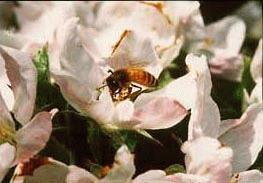Honeybee Gallery
Honeybee Publications
 Some facts about the honeybee:
Some facts about the honeybee:
- First managed by humans around 5,000 B.C.E. for honey
- Colonies were housed in clay vessels or baskets
- The honeybee is highly social
- A division of labor is strongly developed
- There are three castes:
- Queen – female reproductive, lays all the eggs in the colony
- Drone – reproductive male
- Worker – sterile female, does all foraging, larval rearing and colony maintenance
- Long-tongued: enables them to visit a wide variety of flowers
- Mouthparts form a “straw” which allows them to suck up nectar
- Wax is secreted from their bodies and used to construct comb
- Wax comb is used to store honey, pollen and house larvae and pupae
- Workers readily defend their colony
- Sting is barbed to ensure maximum envenomation (unique among insects)
- Stinger and venom sack is pulled from the body of the bee which leads to the bees death
- Communicate using a dance language inside the hive; tells the direction, distance and quality of food
- Responsible for 80% of all insect pollination in the U.S.
- Worth approximately $14.6 billion to U.S. agriculture
Africanized (“killer”) bees
- have killed 6 people in the U.S. so far
- are identical in appearance to European Honeybees
- sting has same strength as European honeybees
- responds more quickly and in greater numbers to percieved threats to the colony
What to do if attacked:
- Run until they stop chasing
- Get indoors
- Get victim to hospital immediately
- Scrape stingers out with a fingernail
Other recent threats to the honeybee industry
- Varroa mites – large external mites that feed on developing larvae
- Tracheal mites – tiny mites that feed on inside of bees tracheal (breathing) system
- Small hive beetle
- Resistance of American Foulbrood to Oxytetracyline
- Red imported fire ants found on honeybee equipment resulting in quarantine holds for bees entering California
- Price of honey dropped from $0.91 per pound in Jan. 1997 to $0.61 per pound in Aug. 2000
For More information about honeybees:
- http://gears.tucson.ars.ag.gov/
- http://weber.u.washington.edu/~jlks/bee.html#archive
- http://www.nhb.org/
